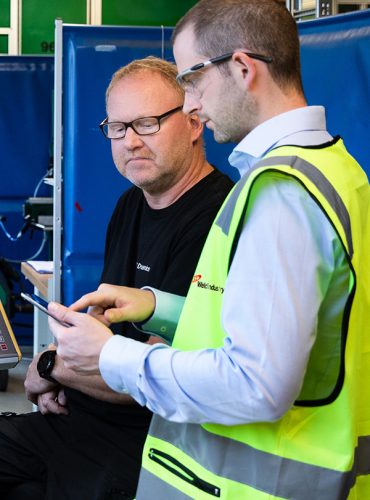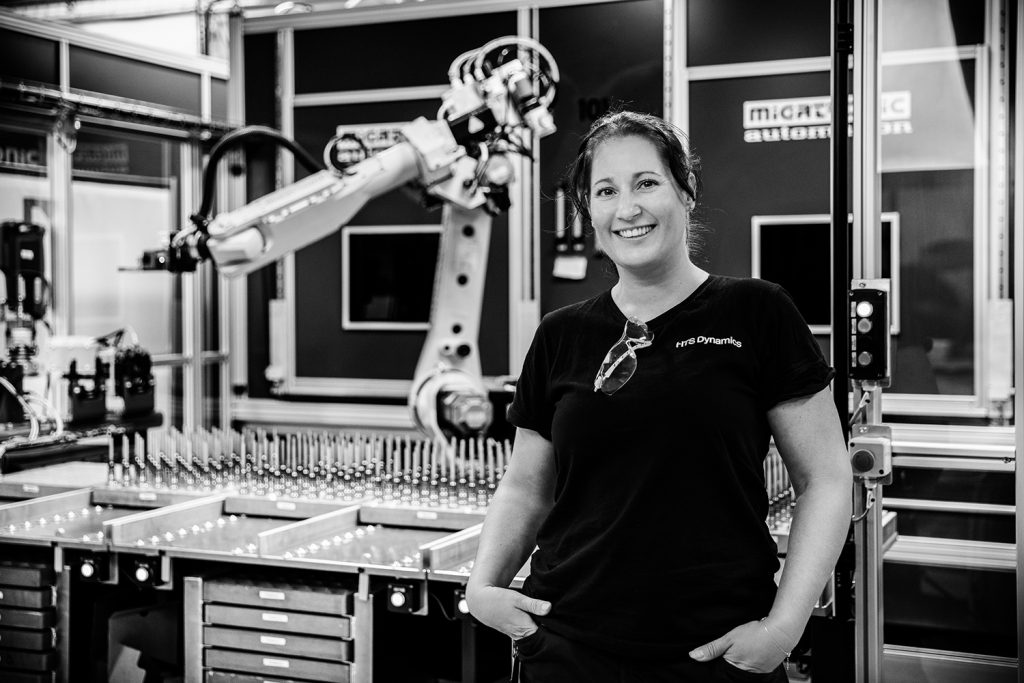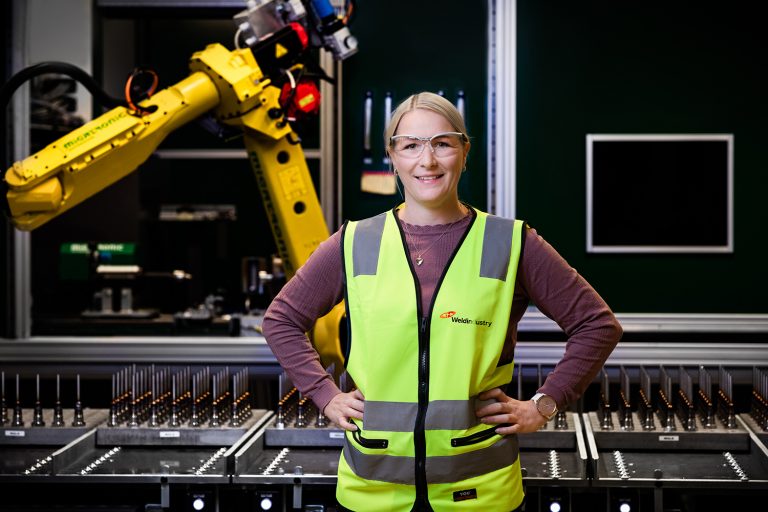
At the forefront of
Industry 4.0
Cecilie Nøstdal from HTS Dynamics
HTS and Weldindustry photographs by Ingar Sørensen
Making an Industry 4.0 smart factory a reality
We are extremely lucky to have had the opportunity to visit a valued customer of ours – HTS Dynamics – currently at the forefront of incorporating Industry 4.0 into their smart factory.
We are interested to see how they are interpreting and implementing Industry 4.0 and what it takes to make a smart factory a reality. This also includes how they are integrating the climate change challenges into their processes and addressing the effects on the employees too.
Optimised Tools + Setup = Performance
HTS Dynamics is a world leading manufacturing company providing critical machining, welding, and assembly services for the subsea technology industry.
Their vision: Shaping the Norwegian Industrial Adventure through People, Planet and Technology.
Through intelligent research and evaluation, they are employing a successful manufacturing process that involves print machining, robotic welding, and assembly of critical mechanical components of small dimensions and advanced materials to the subsea industry.
All products are delivered with the lowest carbon footprint possible from their production facility in Drammen, just outside of Oslo.
This is one of Norway’s largest production lines of small to mid-sized automated CNC machines.
The fleet of machines has been designed to work with demanding materials such as Superduplex, Duplex, Inconel 625, Nitronic, 316L.

What are the results of this setup?
HTS is a market leader of welding small-bore tubing. Their production uses fully automated welding stations allowing a capacity of up to 30,000 welds per year.
The subsea industry – A competitive market
Advanced materials, high criticality, demanding tolerances, complex specifications and standards – these are just a few challenges that come with supplying components to the subsea industry. Over the years, HTS has developed a solid ability to meet complex and critical deliveries to their customers.
With over 30 years of projects under their belt and more than 650,000 valves installed on the seabed around the world – with zero faults – the stats speak for themselves and give their customers confidence in delivery, year after year.
How do you bring about these kinds of results?
Several years ago, HTS began a journey to evaluate their factory and tooling setup, paying particular attention to the aspects of production that were important to their customers, mainly oil and gas companies. They have taken this onboard and applied these principles to their manufacturing processes, looking to digitalisation and new techniques to identify where more benefits could be found.
The result is a world class manufacturing facility that uses the latest technology to provide high quality products to subsea industry. HTS Dynamics runs a fully cloud connected smart factory with a high level of automated processes and is a frontrunner within Industry 4.0 manufacturing in Norway.
Number of faults reported from valves
0
Launching the HTS Dynamics 4.0 program
HTS have looked to Industry 4.0 principles and developed their own HTS 4.0 program where the aim is to do more with the same level of resource. Embracing automation leads to improvement. It encourages creativity, increases capacity, and decreases cost. The effects of having a high robot density in their manufacturing (15 times higher than global manufacturing average) has given a highly competitive edge.
It’s not just hardware; software automation and integration removes duplication and manual input, providing a system that has lower risk opportunities and overall improved quality. The cloud connected smart factory uses the state-of-the art IoT (Internet of things) system to forecast any potential waste and bottlenecks before they materialise and optimise efficiency through integrations between software packages, for example, the ERP/MES software, to allow quick comparison of planned vs. actual production and analysis of deviations.
Embracing new technology for a sustainable climate
The HTS climate initiative aims for Net Zero carbon emissions by 2040, and 50% turnover from renewables and low carbon projects in 2030.
HTS Dynamics strongly believe the energy industry needs to lead the way in the green transition. They have done extensive research into modernisation and digitalisation that can help address this challenge. It is a difficult topic in an industry where, if any supplier in the value chain falls foul of carbon emission targets, be it through poor processes or management, it can have a detrimental impact to the end customers’ carbon footprint.
HTS is actively helping their customers decarbonise their value chains. As a global supplier to the energy industry, they have a particular responsibility for sustainable development and halting climate change.
Norwegian oil and gas companies are starting to factor the carbon aspect into their tender and bidding processes. HTS’ awareness of this has resulted in great improvements in their own processes for reaching a greener and more sustainable future. This extends to raising awareness with suppliers and customers to try influence the whole value chain that they are all part of.
This is where companies like HTS are making gains and moving ahead with a competitive advantage. Proof of green is now on the agenda of well-known O&G operators and choosing a sustainability focussed supplier is something they value.
What can we take away from this?
The principles of Industry 4.0 can be applied to all manufacturing industries, and thanks to leading companies like HTS, others can see how they work in real life.
In an Industry 4.0 driven smart factory, the question of why production targets are not being met no longer requires extensive investigation, consuming valuable personnel and resources away from the critical path of production. The answer lies in the data that is immediately available and accurate. Every “why” requires resources to investigate. This highlights one of the key reasons to become an online connected smart factory – reduced decision-making times and readily available production data that can be used as evidence. For instance, employing a digital management software system like WeldEye allows you to capture the data of your welding processes and shows you the metrics in real time. Traceability goes hand in hand with data capture, allowing root causes to be found almost immediately. Access to this data allows production to be more efficient, faster and require less resource and supervision.
We at Weldindustry are now more aware of this too. We offer a greener approach to weld traceabilty through our Welder’s WeldEye solution where welders can report the status of welds and NDT via a tablet or hand held device directly into WeldEye, removing large amounts of paper from the traceability process.

The effect of the pandemic on digitalization
There is now no doubt that the COVID pandemic accelerated the digitalisation process across a wide range of industries. Not having infrastructure in place to allow tasks to be carried out remotely, being restricted to only essential staff allowed onsite, sped up the implementation of new technology and forced staff and managers alike a new perspective.
One of the biggest changes to workflow was the adoption of online meetings, resulting in increased offsite decision making. The ability to show production data and metrics onscreen became more important than ever. We now have several years’ experience with these practices, and many have proven themselves so useful that they are here to stay.
The challenge for companies now is to keep up this momentum for change, as it clearly showed how being flexible and having a willingness to adopt better or different solutions, resulted in higher chances of survival and prosperity.
Obstacles and removing digital scepticism
It was a good opportunity for practical operators to understand the need for digitalisation. The pandemic opened a lot of eyes to how vulnerable even the best operating factories can be. In some cases, digitalisation and modernisation has been the only way forward to ensure the survival of the company.
For some it may have been the simple acceptance that a digital sign off is no less effective than a physical signature. The belief that a document must be printed, signed and scanned is a practice that is no longer part of an efficient workflow. Thanks to the mandatory procedures put in place to avoid the spread of viruses, the trust in digital systems has grown. The impact of these digital systems and the amount of monitoring available encourages better behaviour, productivity and decision making from employees and managers alike, as it exposes losses in productivity, be that measured in time, cost or quality.
Digitalisation and modernisation at HTS Dynamics
HTS has expanded from producing and delivering mechanical components to now also supplying welded components. This took bravery from the leadership, as it involved embracing another complex set of standards and requirements, but proved to their customers that HTS has full confidence in their ability to deliver.
The ability to deliver these welded components is in large due to the robots, but robots are nothing without their operators and support staff. HTS takes great care of and interest in their employees and their workplace. They provide a variety of tasks to keep the workshop an interesting place with room for growth and development. They believe that change is a good thing and having a strong purpose and great working environment is the key to excellent employee satisfaction.
Their stated aim is to be the best workplace in Norway!

The awareness of the effect of modernisation on the workforce is clear to HTS management and it’s a topic that is addressed upfront. As an employer, HTS are very aware of the effect replacing jobs and procedures with automation can have on their workforce, but by tackling these issues head on, they show how change is not always something to be worried about. This is a wise approach that should be adopted by others if they are to follow on in the successful, digital footsteps of HTS.
The robots are good at repeatability and achieving quality, but the activities in between are human and will be for a long time to come.

Conclusion

Is it worth committing to modernising welding practices? HTS is a prime example that it is. Their approach has established further trust with customers in delivery and quality and the HTS orderbooks are proof of this.
HTS has developed an efficient welding process resulting in low rejection and defect rates, as well as less waste and emissions. With close to no repair welding, they are not only saving raw material costs, production time and emissions, but the improvement in quality makes them more attractive to new customers too. This confidence in their welding abilities allows them to invest in stock early to anticipate future project wins, therefore becoming buffered from any fluctuations that come with the subsea market.
HTS use WeldEye to manage their digital library of welding procedures and qualifications and Weldindustry is proud to be part of their onward digitalisation journey.
Thank you to HTS for giving Weldindustry an insight into what it’s like to employ an Industry 4.0 strategy and making it a reality.
For some companies, the impact of losses through errors and repairs can perhaps be absorbed in the short term, but for an agile business, who has access to the data to back it up, removing these losses can increase opportunities and competitiveness. This concept is well known as continuous improvement and it’s a well-established area of focus for all successful manufacturing companies. Process evaluation is a necessary activity, reviewing and refining how to build your products with processes that use less resources, give off less emissions and therefore improve your company is the way forward.
Visiting a visionary company like HTS shows that investing in Industry 4.0 pays off.
HTS is showing how a real-life company can operate successfully using Industry 4.0 principles.
Thank you for your hospitality and insights.

WeldEye Management by Weldindustry
Weldindustry AS, Drammensveien 288,
0283 Oslo, NORWAY
Org. no. 983 448 224
